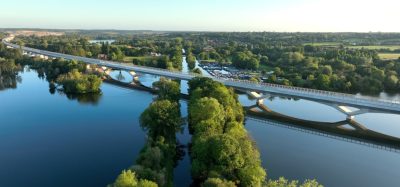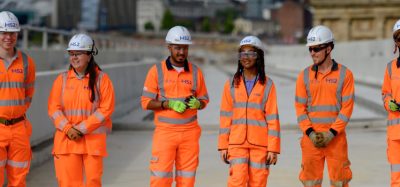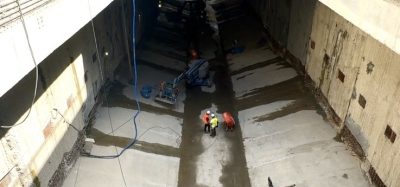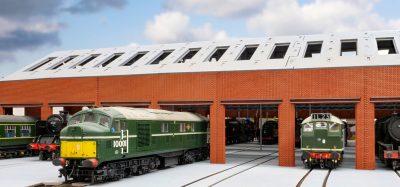Finnish slab track study for Airport Line
Posted: 15 May 2009 | | No comments yet
Details of the study of a slab track system for the new Ring Rail Line conducted in Vantaa, Finland for Finnish Railway Administration by Pöyry Infra Ltd and VR-Track Ltd Railway Consulting department.
Details of the study of a slab track system for the new Ring Rail Line conducted in Vantaa, Finland for Finnish Railway Administration by Pöyry Infra Ltd and VR-Track Ltd Railway Consulting department.
During spring 2008, a study of a slab track system for the new Ring Rail Line was conducted in Vantaa, Finland interlinked with the railway planning phase. The study concentrated on the seven kilometre long double tunnel system which would go under the Helsinki-Vantaa Airport area. The main task was to investigate the suitability of a slab track system as an alternative for a traditional ballasted track from the given starting points and in Finnish conditions. It was expected through international experience that slab track would present advantages concerning future maintenance, tunnel safety and also savings in tunnel excavations. The study was made for Finnish Railway Administration by Pöyry Infra Ltd and VR-Track Ltd Railway Consulting department.
The Ring Rail Line is a new internationally important railway connection planned in the Helsinki Metropolitan Area. The 18km long line connects two existing urban railway lines and provides a direct connection between the Airport and Helsinki city centre. The line creates a high-class circular connection and good possibilities for developing new residential and commercial areas in the region. Trains will stop at all stations and the line is planned to be operated mainly with new Stadler Flirt EMUs. At the moment the detailed design phase for the tunnel section is on-going and building is scheduled to commence in spring 2009 with tunneling contracts. The Ring Rail Line is scheduled to be opened in 2014.
Starting points and objectives for the study
There are many different variations of slab track systems in use worldwide. In Finland, slab track is used today only on some specific locations so the possible implementation of a slab track system to Ring Rail Line sets tight requirements for the study. For this study, system designs similar to Rheda or Stedef systems were set as a starting point. Here the Finnish standard concrete sleeper would be used with minor changes on the production line to ensure an economical slab track structure. The sleeper also establishes the railway gauge and rail inclinations in the slab track. The important elasticity and ground-borne noise damping properties were set to be done with either:
- Sateba’s SAT S 312 system, where the sleeper is elastically supported and isolated from the concrete slab
- With Vossloh’s System 304 fixation system, where the damping element is situated below the rail and the sleeper is encased to the concrete slab
The slab track systems were compared with a standard ballasted track in tunnel. Good basis for the comparison was obtained from the Vuosaari Harbour railway line where a 13km single track tunnel for freight trains was opened in November 2008.
The tunnel system
The slab track structure track geometry, tunnel system and also tunnel excavation and available building methods set the framework for the study. In the tunnel section, the track geometry has two long curves and a crossing place with four switches. The maximum speed for the track is 120km/h and the maximum longitudinal inclination was set to 40 per mille.
The tunnel system of the Ring Rail Line consists of two separate single track tunnels which are connected with connection/exit tunnels in maximum of 200 metre intervals. In the first construction phase, two tunnel stations and a station reservation will be completed. Also, there will be shafts in 1000 meter intervals and at both ends of tunnel stations. In case of an accident, the adjacent tunnel serves as a safe route to the nearest exit.
Tunnel excavations will be done with drilling and blasting method with tolerances of 0-400mm or 0-200mm. The TBM method is also possible but not necessary because of the good quality rock in the area. The excavated tunnel is reinforced and concrete spraying is used where necessary. Finally, the tunnel is equipped with a drainage system and several technical systems which require undershoots below the track structure.
Ground-borne noise isolation
The maximum ground-borne noise level LASmax was set to be 40 dB for commercial buildings and 30 dB for residential buildings. Since the tunnel section is mainly situated below the Airport, the 40 dB level is adequate in most part of the tunnel. In the eastern end the requirement is 30 dB. During the design it was calculated that with Sateba’s SAT S 312 system it is possible to reach the 30 dB allowed level, but this means over 3mm deflection with the design axle load 250 kN. With Vossloh’s System 304, the damping effect is reduced because of a smaller mass over the element but it was estimated that the 40 dB level is possible to reach.
Defined structures
In the study, two alternative slab track solutions were defined.
Structure 1
Structure 1 consists of a reinforced surface slab fixing the track and a base slab made of zero-slump concrete (hydraulically bonded layer). The structure is founded on a cleaned rock surface or on a compressed layer of crushed stone.
Structure 2
Structure 2 consists of a reinforced concrete trough made either from prefabricated elements or by slip casting. The trough is based on a compressed layer of crushed stone. The track is fixed with a surface slab made from steel fibre reinforced concrete.
Because of the sleeper, the building is performed with a ‘top-down’ method. The structures were adapted to the tunnel cross-section, where the width of the tunnel is defined by the Finnish clearance gauge and technical systems. This meant that with slab track the possibility to reduce the cross-section came from lifting the rock bottom. On cleaned rock surfaces the maximum reduction was 4m2.
For the switches, a line drawing was made for a slab track switch with a structure based on the SAT S 312 system. Here standard concrete sleepers can be used with minor changes. The steel parts are the same as with switches for ballasted track, and thus the assembly and maintenance can be carried out with mainly the same methods. The great advantage is that the slab track switch doesn’t require tamping. Also, transition zones between slab track and ballasted track preliminary plans for SAT S 312 and System 304 based slab tracks were defined.
The cost calculation for the slab track system
In cost calculation problems such as scope, measurement, appreciation, allocation and sectioning problems need to be addressed. The scope problem was solved by accounting only for those components that differed between ballasted and slab track, while other components were assumed to have the same cost or be irrelevant. Measurement and appreciation problems were tackled by using existing components and working methods whenever possible. The unit costs and amounts of both material and labour were obtained from Rapal Oy1 and expert estimations.
Hidden costs with slab track that are difficult to account for include:
- Learning new work methods
- Importing relevant competence
- Transport, use and maintenance of existing special machinery needed with slab track
- Need to develop new pieces of special machinery
However, some of these costs can have a monetary value in a bid-and-tender process. Hidden costs can increase the reference cost of slab track substantially.


Allocation problem refers to allocating overhead costs that are common for several product groups or departments. Here they were allocated as € / track-km. The sectioning problem is about dividing the investment costs and its benefits over time. For slab track, the investment takes place at the beginning. A more difficult issue is to estimate how much lower the maintenance costs of slab track are. Maintenance costs of both ballasted and slab track including maintenance measures, their unit costs and their point of time were assessed by a maintenance service provider. Table 1 shows the cost difference of most cost-efficient ballasted and slab track alternatives. The investigated installation lengths of slab track were 6,600 and 10,900 track-m.
Overhead costs of slab track, such as transition structures and investments in production lines for sleepers and switches, were estimated by respective vendors and amount to €35-€52 / track-m. Hence, the slab track was found to be €486-€503 / track-m more expensive than ballasted track. With Sateba’s SAT S 312, the cost increase compared with System 304 was €187-€204 / track-m depending on the length of installed slab track.
Lifecycle costs
The assumptions for life cycle costs of ballasted and slab track were as follows:
- A ballasted track has the same maintenance measures both in tunnel and on open track
- Maintenance costs of rails and fixation systems do not differ significantly
- A concrete sleeper has a life span of 40 years with ballasted track and 60 years with slab track
- Due to more stable conditions in tunnel than on open track, it can be expected that:
- crushing and grinding of ballast is reduced, so ballast needs to be replaced or sieved every 40 years
- however, it is still assumed that the ballast needs supporting every six years
- Major advantage of slab track is that the switches need less supporting
- Transition structures between ballasted and slab track can cause additional lateral and longitudinal stress to rail and fixation
The profitability of an investment can be estimated by, e.g., its payback time, Net Present Value (NPV) or Internal Rate of Return (IRR). For the purposes of this study, NPV was found to be the most suitable method, whereas investment payback time was used as an instrument for checking.
The additional maintenance cost for ballasted track was approximately €7,000 / track-km / year. With higher investment costs of slab track and excluding its hidden costs, the results are as follows:
- Investment payback time of slab track would rise as high as 69-72 years.
- Net Present Value: if the yearly rise of costs (≈ inflation) is between 3% and 6%, with an NPV = 0 the slab track needs to be financed with an interest rate that is 0,8%-1,1% lower than inflation. This is not realistic as most investors require for a risk-free investment a return which is at least equal to inflation
To sum up, the slab track investment is, in this case quite difficult to argue from an economic point of view. The initial investment is very large compared to benefits, which are distributed for a very long period of time. This also means that uncertainty associated with benefits is significant. Because the results were clear enough and the model simple enough, it was decided there was no need for sensitivity analysis or changing the interest rates or component prices through the decades.
Procurement methods
During the study, the procurement methods were also taken into account. Slab track is a demanding special structure, which has not yet been realised in Finland in large-scale railway investments. Thus considerable attention must be put on the acquisition method of slab track. Four alternatives were created where the responsibility of the overall solution varies between the client and the entrepreneur. Basic solutions are:
- Products approved by the client, where acceptable slab track solutions are defined
- Realisation of a structure according to the plans of the client
- Realisation of a structure according to the plans of the entrepreneur
- Service contract, where the client would buy railway capacity from the entrepreneur
Summary and recommendations
Because sufficient savings or advantages compared to the greater investment costs were not reached, traditional ballasted track was preferred for the tunnel section. In future railway projects, slab track solutions should be investigated, when the demand for network capacity would be heavy from the start or on which there are wide areas with ground-borne noise level requirements of 30 dB. The selection of procurement method and the slab track system itself should be considered in the early phase of these projects, because the large scale adoption of a slab track system needs to be well planned and organised.
Even though the ballasted track was in this case chosen, something new is coming. The tunnel section will be equipped with an overhead conductor rail, which improves the tunnel fire safety. Its investment cost is higher, but it is covered by the reduction of cross-section. Under sleeper pads will be used on the tunnel switches to improve their stability. Also, the possibility to use under sleeper pads as a ground-borne noise damping element is being tested and if results are good, they could be implemented in a larger scale in the tunnel section.
Reference
- Rapal Oy is a Finnish company specialised in infrastructure investment and maintenance costs. See http://en.rapal.fi
OUT NOW: The Definitive Guide to Rail’s Digital Future
The rail industry is undergoing a digital revolution, and you need to be ready. We have released our latest market report, “Track Insight: Digitalisation.”
This is not just another report; it’s your comprehensive guide to understanding and leveraging the profound technological shifts reshaping our industry. We move beyond the buzzwords to show you the tangible realities of AI, IoT, and advanced data analytics in rail.
Discover how to:
- Optimise operations and maintenance with real-time insights.
- Enhance passenger services through seamless, high-speed connectivity.
- Leverage technologies like LEO satellites to improve safety and efficiency.
Featuring expert analysis from leaders at Nomad Digital, Lucchini RS, Bentley Systems and more, this is a must-read for any rail professional.







